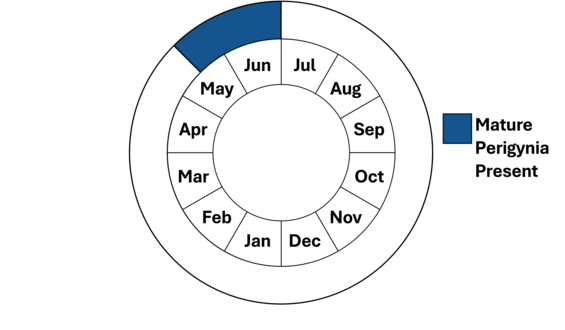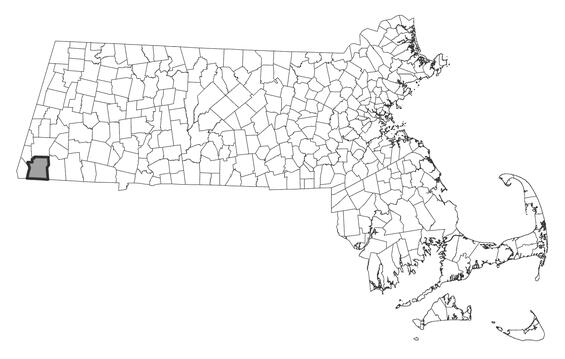- Scientific name: Carex oligocarpa
- Species of Greatest Conservation Need (MA State Wildlife Action Plan)
- Threatened (MA Endangered Species Act)
Description
Rich woods sedge (Carex oligocarpa) is a perennial sedge (family Cyperaceae) of rich, often rocky, forests and woodlands in high-alkaline bedrock regions. It grows in dense tufts, with delicate stems and linear leaves, reaching up to 80 cm (2.6 ft) in height. A member of the Carex section Griseae, rich woods sedge is relatively nondescript, and could be easily overlooked without careful examination of its key morphological characteristics. Rich woods sedge is also called few-fruited sedge (Latin translation of oligocarpa is oligos for “few” and carpon for “fruit”). Rich woods sedge has reddish purple leaf sheaths at the base of the plant.
At least three other species within Carex section Griseae are similar to rich woods sedge. Gray sedge (C. grisea) and stiff sedge (C. amphibola) both have perigynia that loosely envelop the achenes; gray sedge differs further in that it is orbicular in cross section. Further, unlike rich woods sedge, both species have a lowermost bract with a loosely clasping sheath, wider leaf blades, denser, spirally arranged pistillate spikes, and perigynia with shorter beaks. Another similar species, Hitchcock’s sedge (C. hitchcockiana; Special Concern), has rough, hairy leaf sheaths and culms that are brown at the base. Lastly, a species in Carex section Laxiflorae that occurs with rich woods sedge, woodland-sedge (C. blanda), has wider leaves, crowded perigynia with bent beaks, and brown sheaths.
Life cycle and behavior

Sedges of the genus Carex have small unisexual wind-pollinated flowers borne in spikes. The staminate (male, pollen-bearing) flowers are subtended by a single flat scale; the pistillate (female, ovule-bearing) flowers are subtended by one flat scale (the pistillate scale) and are enclosed by a second sac-like modified scale, the perigynium. Following flowering, the achene (a dry, indehiscent, one-seeded fruit) develops within the perigynium. The morphological characters of these reproductive structures are important in identifying plants of the genus Carex to species. Rich woods sedge is a rhizomatous clump-forming plant that is conspicuously purple-red at the base. The leaf blades are narrow (≤4.6 mm [0.18 in] wide); both the blade and the sheath are glabrous. Like other sedges in Carex section Griseae, rich woods sedge has terminal staminate spikes, lateral pistillate spikes, and impressed perigynia veins. The pistillate spikes are loosely flowered with 2 to 8 perigynia, many borne in 2 ranks, and subtended by long-awned scales. The shape of the perigynium in cross section is obtusely triangular, and the surface is finely many-veined; it has a beak up to 1.2 mm (0.05 in). A distinctive feature of this species is that the perigynia tightly adhere to the achenes and are not wrinkled or inflated as in other species; in addition, the lower-most bract of the inflorescence has a tightly clasping sheath. Mature perigynia are present late spring into early summer.
Population status
Rich woods sedge was recently re-discovered in Berkshire County of Massachusetts after not being observed for nearly 100 years. It is also historically known from Franklin County. Rich woods sedge is listed under the Massachusetts Endangered Species Act as threatened. All listed species are protected from killing, collecting, possessing, or sale and from activities that would destroy habitat and thus directly or indirectly cause mortality or disrupt critical behaviors. Rich woods sedge has one population that has been verified since 1999.
Distribution and abundance
Rich woods sedge is known from eastern-central Canada (Ontario, Quebec) and across the much of the eastern half of the United States, excluding eastern New England and Louisiana.

Distribution in Massachusetts. 1999-2024. Based on records in the Natural Heritage Database
Habitat
In Massachusetts, rich woods sedge inhabits the rich soils of a dry woodland on a calcareous rocky summit. Associated species include eastern red cedar (Juniperus virginiana), northern prickly ash (Zanthoxylum americanum), four-leaved milkweed (Asclepias quadrifolia), ebony spleenwort (Asplenium platyneuron), woodland-sedge (Carex blanda), enchanter’s nightshade (Circaea canadensis), herb-robert (Geranium robertianum), white avens (Geum canadense), rockcap-fern (Polypodium virginianum), three-lobed violet (Viola palmata), bloodroot (Sanguinaria canadensis), and various mosses.
Healthy habitats are vital for supporting native wildlife and plants. Explore habitats and learn about conservation and restoration in Massachusetts.
Threats
Exact management needs of rich woods sedge are not known. As with all species, however, maintaining habitat quality is essential. Alterations to the soils, cobble ridges, and structure of its woodland habitat could adversely affect the population. Natural processes such as succession that reduce the amount of available light could result in over-shading of plants over time.
Conservation
Rich woods sedge habitat should be monitored for exotic invasive species that can out-compete native plants for nutrients and light, excluding them over time. Some invasive plants, such as garlic mustard (Alliaria petiolata) are allelopathic, meaning they can change the soil chemistry to inhibit the viability of native plants. Garlic mustard and aggressive shrubs such as Japanese barberry (Berberis thunbergii) and common buckthorn (Rhamnus cathartica) are invasive species of concern within the plant community that supports rich woods sedge. If exotic plants are invading rich woods sedge’s habitat, a plan for control should be constructed.
Contact
| Date published: | April 9, 2025 |
|---|